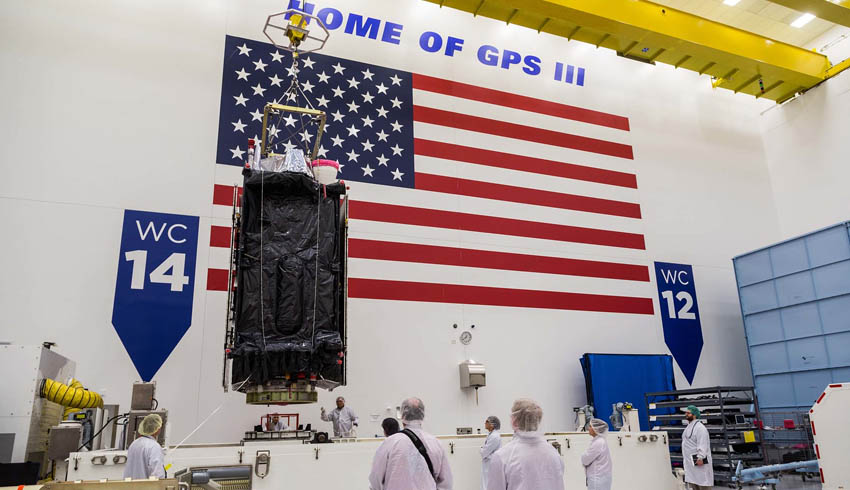As part of the US military’s effort to modernise GPS, the US Space Force has been steadily upgrading its existing GPS Ground Operational Control System (OCS).
The Space Force recently announced operational acceptance of the GPS Contingency Operations (COps) upgrade, developed by Lockheed Martin.
COps enabled control of the operational GPS constellation, now containing 21 M-Code capable GPS satellites, including Lockheed Martin’s first two GPS III satellites, until the next-generation OCX ground control system is delivered.
The Space Force’s M-Code Early Use (MCEU) upgrade, delivered earlier this year, will enable the OCS to task, upload and monitor M-Code within the GPS constellation, as well as support testing and fielding of modernised user equipment, prior to the completion of the next-generation ground control systems.
This Spring, work will begin to install the components needed to command and monitor the M-Code encrypted GPS signal, which enhances anti-jamming and protection from spoofing, as well as increases secure access for our forces, into the GPS OCS. M-Code signals are currently available on all the on-orbit GPS IIR-M, IIF and III space vehicles.
Johnathon Caldwell, Lockheed Martin vice president of navigation systems, explained, “Our warfighters depend on GPS signals every day for many critical missions, so anything we can do to make these signals more resistant to jamming and spoofing is extremely important – and available today.”
A key to enabling M-Code is a new software-defined receiver Lockheed Martin developed and is installing at all six Space Force monitoring sites.
The M-Code Monitor Station Technology Capability (M-MSTIC) uses a commercial, off-the-shelf general-purpose graphics processing unit (GPU) to cost effectively receive and monitor M-Code signals.
“The more powerful GPS III/IIIF satellites coupled with Lockheed Martin’s upgrades to the GPS ground system are making that possible,” Caldwell added.
Operators can monitor the signal as needed. M-MSTIC complements MSTIC’s, which Lockheed Martin developed and fielded to replace ageing hardware receivers that were becoming difficult and expensive to maintain.
On 27 March, the Space Force declared operational acceptance of Lockheed Martin’s second GPS III satellite. Another M-Code enabled satellite, GPS III Space Vehicle 02, nicknamed 'Magellan', is modernising today's GPS satellite constellation with new three times greater accuracy and up to eight times improved anti-jamming capabilities. GPS III also provides a new L1C civil signal, compatible with other international global navigation satellite systems, like Europe's Galileo.
Lockheed Martin is currently contracted to build up to 32 GPS III/GPS III Follow On (GPS IIIF) satellites to help modernise the GPS constellation with new technology and advanced capabilities. The delivery tempo for these modernised GPS satellites will allow for several launches per year.
The third M-code enabled GPS III satellite, named 'Columbus', is expected to launch in April 2020.
Cyber defences across the upgraded GPS system were recently evaluated by a government assessment team and passed the Operational Utility Evaluation.
Lockheed Martin delivered the Red Dragon Cybersecurity Suite (RDCSS) Phase III upgrade during the fourth quarter of 2019, dramatically improving defensive cyber operations (DCO) visibility into GPS network traffic. Other add-ons include user behaviour analytics to analyse patterns of traffic and network taps to improve data collections.
Stacy Kubicek, vice president of mission solutions defence and security explained the importance of such capabilities, saying, “GPS is an attractive target for our adversaries, so it was critical we bring our best cyber security defences to the table. Since we began sustaining the Ground OCS in 2013, we have systematically upgraded and replaced software and hardware – it’s now a very secure system.”
Lockheed Martin has sustained the GPS Ground OCS since 2013. In November of 2018, the team completed the AEP 7.5 architectural change – replacing the hardware and software to improve resiliency and cyber security.
In December of 2018, the Air Force awarded Lockheed Martin the GPS Control Segment Sustainment II (GCS II) contract to further modernise and sustain the AEP OCS through 2025.

